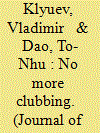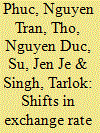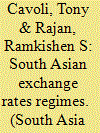|
|
|
Sort Order |
|
|
|
Items / Page
|
|
|
|
|
|
|
| Srl | Item |
| 1 |
ID:
154531


|
|
|
|
|
| Summary/Abstract |
This paper examines exchange rate behaviour in the ASEAN-5 countries (Indonesia, Malaysia, the Philippines, Singapore, and Thailand). It finds that for the last ten years, there is no evidence that their central banks target particular exchange rate levels against any currency or basket. Thus, contrary to some assertions, they do not belong to a dollar club, a yen club, a renminbi club, or an ASEAN club. At the same time, they clearly try to smooth short-term volatility, particularly vis-à-vis the U.S. dollar. The degree of smoothing declined noticeably after the Asian Financial Crisis and less obviously after the Global Financial Crisis, with heterogeneity across countries. Short-term smoothing without level targeting does not interfere with monetary policies aimed at price stability.
|
|
|
|
|
|
|
|
|
|
|
|
|
|
|
|
| 2 |
ID:
132575


|
|
|
|
|
| Publication |
2014.
|
| Summary/Abstract |
A number of studies have found that more flexible exchange rate regimes tend to be associated with greater inflation persistence. This paper investigates whether this finding is applicable to Vietnam from 1992 to 2010. We find no evidence to suggest that inflation persistence in Vietnam was systematically higher under a "soft" peg exchange rate regime than under a "hard" peg. Rolling regressions suggest that inflation persistence peaked during 2004 to 2007, when Vietnam was governed by what may be characterized as a hard-peg regime.
|
|
|
|
|
|
|
|
|
|
|
|
|
|
|
|
| 3 |
ID:
121189


|
|
|
|
|
| Publication |
2013.
|
| Summary/Abstract |
This article presents an analysis of the degree of de facto exchange rate flexibility in the exchange rate regimes for selected South Asian economies, viz., Bangladesh, India, Pakistan and Sri Lanka. Three commonly employed measures of exchange rate classification are used: a simple exchange market pressure (EMP) measure, a GARCH specification and a regression-based model. The article finds strong evidence of limited flexibility in all the South Asian economies-particularly against the US dollar, which can suggest a heavy degree of currency management. While Bangladesh, Pakistan and Sri Lanka effectively have fixed exchange rate regimes vis-à-vis the US dollar, India appears to operate somewhat more as a managed floater with a movement towards greater flexibility in recent years.
|
|
|
|
|
|
|
|
|
|
|
|
|
|
|
|
|
|
|
|
|